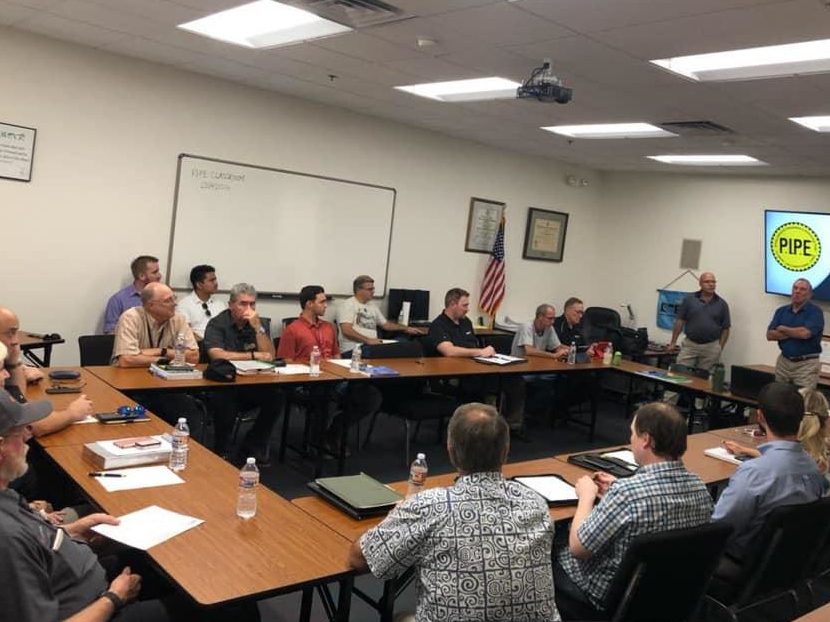Collaborative Health Care Design
When should designers request identity of AHJ?

On the third Wednesday of July, the Piping Industry Progress & Education Fund (PIPE) and our local Phoenix ASPE chapter members met for our monthly meeting to discuss all things under the sun medical gas-related.
It was a great turnout, and we had meaningful discussions in the open-forum presentation. Health-care facility representatives, city officials, inspectors, verifiers, installers, engineers and manufacturers attended the presentation.
Here is a brief list of what the PIPE Medical Gas Committee does all year long (and there is so much more not shown):
- Communicate to the local industry what is required by code and discuss the intent of said code
- Discuss field-related issues and best practices to rectify them
- Discuss brazing qualifications and requirements
- Develop code verbiage to submit to NFPA 99 for consideration
- Discussions with state health departments
- Discussions with state dental boards
The presentation briefly covered how to navigate the health-care categories in Chapter 5 and Chapter 15 of the 2018 NFPA 99 Health Care Code and the sedation levels in Chapter 4. Required documentation was covered regarding installers, inspectors, verifiers, brazing processes and procedures, and city and state requirements.
We touched on the FGI “AIA Design Guide for Health Care Facilities” Table 2.1-6 for hospitals, indicating the required inlets and outlets for departments within a health-care facility. Possible locations of emergency oxygen supply connection were discussed, as well as required construction materials and stand-off distances. Zone valve placement was another heavily debated conversation regarding line of sight and critical-care space requirements.
We also discussed the reoccurring issue of who the AHJ is. It is still one of the more commonly debated topics in the industry when it comes to health care and medical gas systems.
Per 2018 NFPA 99 “3.2.2* Authority Having Jurisdiction (AHJ),” an organization, office or individual responsible for enforcing the requirements of a code or standard, or for approving equipment, materials, an installation or a procedure.
In A.3.2.2 Authority Having Jurisdiction (AHJ), the phrase “authority having jurisdiction” or its acronym AHJ, is used in NFPA documents in a broad manner, since jurisdictions and approval agencies vary, as do their responsibilities. Where public safety is primary, the authority having jurisdiction may be a federal, state, local or other regional department or individual such as a fire chief; fire marshal; chief of a fire prevention bureau, labor department or health department; building official; electrical inspector; or others having statutory authority. For insurance purposes, an insurance inspection department, rating bureau or other insurance company representative may be the authority having jurisdiction. In many circumstances, the property owner or his or her designated agent assumes the role of the authority having jurisdiction; at government installations, the commanding officer or departmental official may be the authority having jurisdiction.”
Still confused? You are not alone, as many are still not sure who the AHJ is. Some ideas of who the AHJ could be in the process include: The facility’s risk department; The engineer of record (EOR); The city inspections department; A third-party inspector; or A third-party verifier.
Throughout the U.S., many jurisdictions will begin with the facility’s risk department to provide a risk assessment (as defined in 2018 NFPA 99 Chapter 4, section 4.2.1.1 and 4.2.2), which, in turn, will be submitted to the AHJ for review (whoever that is).
We know the facility shall conduct a risk assessment and submit it to the AHJ. The next step, we believe, would be to contact your local city jurisdiction to see who would be considered the AHJ from a medical gas standpoint. Will it be the facility’s third-party inspector/verifier, its designee the city official (special inspector) or even the EOR? This needs to be established early in the design process.
The city may or may not have a special inspector program in place, which is basically an approved list of third-party ASSE 6020s or ASSE 6030s, EOR and certified individuals certified by the Medical Gas Professional Healthcare Organization. The city may not have these individuals and opt to accept the facility’s designee.
The 2018 NFPA 99 section 5.1.12.3.2.1 requires the installing contractor’s initial pressure test be witnessed by an ASSE 6020, ASSE 6030, the AHJ or its designee. This last part would indicate the city’s designee. This test shall be recorded and documented. It will be turned over to the verifier at the start of the 24-hour standing pressure test required in section 5.1.12.4.
Early in the design of the project, designers need to request the identity of the AHJ so everyone involved in the project can agree upon the individual, including the city.
The other discussion we had was regarding how to determine the categories of care and sedation levels. These two essential items will help the designer to provide a system that will meet the code and sizing requirements.
As noted in 2018 NFPA 99 Chapter 4, Fundamentals are as follows.
4.1* Risk Categories. Activities, systems or equipment shall be designed to meet Category 1 through Category 4 requirements, as detailed in this code.
4.1.1* Category 1. Activities, systems or equipment whose failure is likely to cause major injury or death of patients, staff or visitors shall be designed to meet Category 1 requirements, as detailed in this code.
4.1.2* Category 2. Activities, systems or equipment whose failure is likely to cause minor injury of patients, staff or visitors shall be designed to meet Category 2 requirements, as detailed in this code.
4.1.3 Category 3. Activities, systems or equipment whose failure is not likely to cause injury to patients, staff or visitors, but can cause discomfort, shall be designed to meet Category 3 requirements, as detailed in this code.
4.1.4 Category 4. Activities, systems or equipment whose failure would have no impact on patient care shall be designed to meet Category 4 requirements, as detailed in this code.
Then, there is 4.2* Risk Assessment and the following.
N 4.2.1 The health-care facility’s governing body shall establish the processes and operations that are planned for the health-care facility.
N 4.2.1.1 The governing body shall conduct risk assessments and shall determine risk categories based on the character of the processes and operations conducted in the health-care facility.
4.2.2* Risk categories shall be classified by the health-care facility’s governing body by following and documenting a defined risk assessment procedure.
N 4.2.2.1 Where required by the authority having jurisdiction, the risk assessment shall be provided to the authority having jurisdiction for review based on the character of the processes and operations conducted in the health-care facility.
4.2.3 A documented risk assessment shall not be required where Category 1 is selected.
These are of some use out there for those who request these processes and operations conducted within the facility to better understand what we are to provide. This helps us determine sizing criteria and equipment selections.
Who does the risk assessment? The governing body shall conduct risk assessments and determine risk categories based on the character of the processes and operations conducted in the health-care facility.
Who does the risk analysis? The health-care facility’s governing body shall classify risk categories by following and documenting a defined risk assessment procedure.
These same types of process and procedures are required to be provided by the installing contractor. What I mean here is that the contractor has its own set of “Brazing Process and Procedures” it needs to provide.
Medical and Dental Sedation Levels
The second part of our discussion focused on sedation levels and what they are. We discussed both parts as it relates to health-care and dental sedation.
2018 NFPA 99 Chapter 3 covers definitions of the different types of sedation.
3.3.66* General Anesthesia and Levels of Sedation/Analgesia.
3.3.66.1 General Anesthesia. A drug-induced loss of consciousness during which patients are not arousable, even by painful stimulation. The ability to independently maintain ventilatory function is often impaired. Patients often require assistance in maintaining a patent airway, and positive pressure ventilation may be required because of depressed spontaneous ventilation or drug-induced depression of neuromuscular function. Cardiovascular function may be impaired. (MED)
3.3.66.2 Deep Sedation/Analgesia. A drug-induced depression of consciousness during which patients cannot be easily aroused but respond purposefully following repeated or painful stimulation. The ability to independently maintain ventilatory function may be impaired. Patients may require assistance in maintaining a patent airway, and spontaneous ventilation may be inadequate. Cardiovascular function is usually maintained. (MED)
3.3.66.3 Moderate Sedation/Analgesia (Conscious Sedation). A drug-induced depression of consciousness during which patients respond purposefully to verbal commands, either alone or accompanied by light tactile stimulation. No interventions are required to maintain a patient airway, and spontaneous ventilation is adequate. Cardiovascular function is usually maintained. (MED)
3.3.66.4 Minimal Sedation (Anxiolysis). A drug-induced state during which patients respond normally to verbal commands. Although cognitive function and coordination may be impaired, ventilatory and cardiovascular functions are unaffected. (MED)”
Chapter 15 of the 2018 NFPA 99 attempted to clarify the sedation levels as it pertains to dental.
N 15.1 Applicability. This chapter shall apply to dental health-care facilities that qualify to install dental gas and vacuum piping systems.
N 15.1.1 Category 1 dental piped gas and piped vacuum system requirements shall be applied in facilities where general anesthesia and deep sedation is performed, as defined in 3.3.65.1 and 3.3.65.2.
N 15.1.2 Category 2 dental piped gas and piped vacuum system requirements shall be applied in facilities where only moderate and minimal sedation is performed, as defined in 3.3.65.3 and 3.3.65.4.
N 15.1.3 Category 3 dental piped gas and piped vacuum system requirements shall be applied in facilities where minimal or no sedation is performed, as defined in 3.3.65.4.”
Basically, this boils down to what questions to ask:
- What level of sedation will you be placing patients under?
- Will patients be at risk (significant injury or death, minimal injury or not likely)?
- If you lose a piece of equipment, what are your emergency steps?
- Request the risk assessment (you may need to request this from the architect). Dental sedation may be different, but the process of documenting is still the same.
As you begin new medical gas projects, remember to request all the required documentation that is required and outlined in the code book. Make sure all parties agree before the design has reached the 50-percent design development level. If you go beyond this time frame, you will likely run the risk of having to change parts of your design, causing you to eat into your budget.





